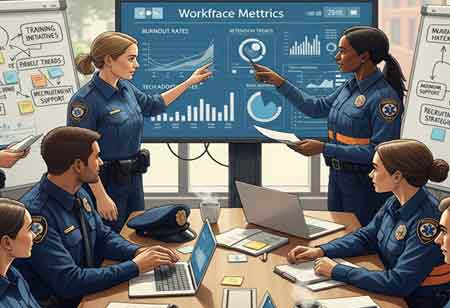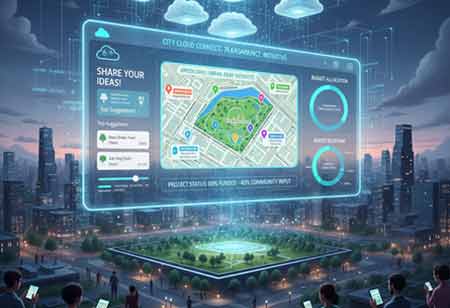THANK YOU FOR SUBSCRIBING
Be first to read the latest tech news, Industry Leader's Insights, and CIO interviews of medium and large enterprises exclusively from Gov CIO Outlook
THANK YOU FOR SUBSCRIBING

By
Government CIO Outlook | Thursday, August 21, 2025
Stay ahead of the industry with exclusive feature stories on the top companies, expert insights and the latest news delivered straight to your inbox. Subscribe today.
The public safety sector, encompassing law enforcement, fire departments, emergency medical services, and dispatch operations, is fundamental to a secure and effective society. Ensuring the era of escalating complexity, the industry is transcending conventional operational paradigms to prioritize its most valuable resource: its personnel. An evolving, integrated strategy for workforce planning addresses burnout, redefines retention, and utilizes technology to facilitate human expertise, thereby fostering a more resilient, sustainable, and effective public safety workforce.
The Proactive Pursuit of Wellness
Public safety work, by its inherent nature, entails routine exposure to high-stress, high-stakes scenarios. The irregular hours, the emotional burden of critical incidents, and the physical rigors of the profession collectively foster an environment where burnout is an occupational inevitability. For many decades, the standard response was frequently reactive. The industry is currently undergoing a fundamental shift towards a proactive and preventive wellness paradigm. This contemporary approach acknowledges that the psychological and physical well-being of personnel is an indispensable prerequisite for operational readiness and the consistent delivery of exceptional community service.
Progressive agencies are embedding wellness into their organizational culture. This extends far beyond simple employee assistance programs. It involves creating an ecosystem of support where seeking help is destigmatized and encouraged. Peer support networks, staffed by trained colleagues who understand the unique pressures of the job, are becoming a cornerstone of this new model. Confidential access to mental health professionals specializing in first responder trauma is increasingly standard.
Leadership is also being redefined. Modern training for supervisors and command staff emphasizes empathetic leadership, emotional intelligence, and the ability to recognize early signs of distress in their teams. The focus is on creating a command structure that is both supportive and authoritative. There is also a growing understanding of the science behind fatigue. Sophisticated fatigue management strategies are being implemented, utilizing data to inform scheduling policies that ensure adequate rest and recovery, thereby reducing the risk of errors and enhancing the long-term health of the workforce.
A New Paradigm for Retention and Growth
The conversation around retention has matured significantly. While competitive compensation and benefits remain essential, they are now understood as just one piece of a much larger puzzle. To retain the invaluable experience of seasoned professionals, organizations are focusing on creating a compelling career-long value proposition that resonates with them. This new paradigm is built on professional growth, purpose, and a genuine commitment to work-life integration.
Career development is at the forefront of this effort. Agencies are moving away from rigid, linear career ladders and toward dynamic career lattices that offer diverse opportunities for specialization and advancement. Providing clear pathways for personnel to develop expertise in emerging fields—such as digital forensics, community engagement, or specialized rescue—enhances not only the agency's capabilities but also fosters a sense of continued growth and engagement among its staff. Mentorship programs are instrumental in this, pairing veteran professionals with newer members to facilitate knowledge transfer, cultivate leadership skills, and foster a stronger institutional culture.
Beyond advancement, there is a renewed focus on reinforcing the intrinsic purpose that draws individuals to public service. This involves consistently and meaningfully recognizing contributions, celebrating successes, and communicating the positive impact the agency is having on the community. By continually connecting daily tasks to the broader mission, leaders can help sustain the motivation that is crucial for long-term commitment. Public safety agencies are finding innovative ways to offer greater scheduling flexibility, such as specialized assignments or family-friendly policies, recognizing that personnel have lives outside of work.
Technology as a Workforce Multiplier
The digital transformation sweeping through every industry is having a profound impact on public safety, particularly in the realm of workforce planning and support. Technology is being adopted not to diminish the human element, but to augment and empower it, freeing personnel from mundane tasks to focus on what they do best: critical thinking, community interaction, and emergency response.
At the core of this shift are sophisticated workforce management systems. These platforms leverage artificial intelligence and predictive analytics to revolutionize scheduling. By analyzing historical incident data, community events, and personnel availability, these tools can forecast staffing needs with remarkable accuracy. This enables the creation of optimized schedules that ensure adequate coverage while promoting fairness, minimizing forced overtime, and adhering to complex labor regulations. The result is a more rested, prepared, and satisfied workforce.
Training is another area being transformed. Immersive learning technologies, such as virtual and augmented reality, are creating hyper-realistic training scenarios that are safe, repeatable, and scalable. Personnel can practice complex tactical maneuvers, de-escalation techniques, and intricate medical procedures in a controlled environment, building muscle memory and decision-making skills without real-world risk. This enhances competence and confidence in the field.
In daily operations, technology is reducing administrative friction. Automated reporting software, mobile data access, and real-time information-sharing platforms are streamlining workflows and reducing paperwork. This crucial time-saving benefit allows officers and responders to spend more time engaged in proactive community service and less time on administrative duties, directly improving job satisfaction and operational efficiency. By harnessing data, agencies can unlock insights that lead to smarter deployment, more effective resource allocation, and a more robust public safety ecosystem overall.
A proactive approach to workforce planning is actively shaping the evolution of public safety. The sector is progressing resolutely toward a paradigm that emphasizes the comprehensive well-being of its personnel, cultivates sustained professional development and vocational fulfillment, and judiciously incorporates technology to bolster and amplify human proficiencies. This integrated approach is pivotal in alleviating professional exhaustion, enhancing personnel retention, and ultimately, delivering the preeminent standard of service to the citizenry. Through investment in its human capital, the public safety domain is not merely preparing for the future; it is constructing a more robust, efficacious, and enduring framework for the communities it is entrusted to safeguard.
I agree We use cookies on this website to enhance your user experience. By clicking any link on this page you are giving your consent for us to set cookies. More info



